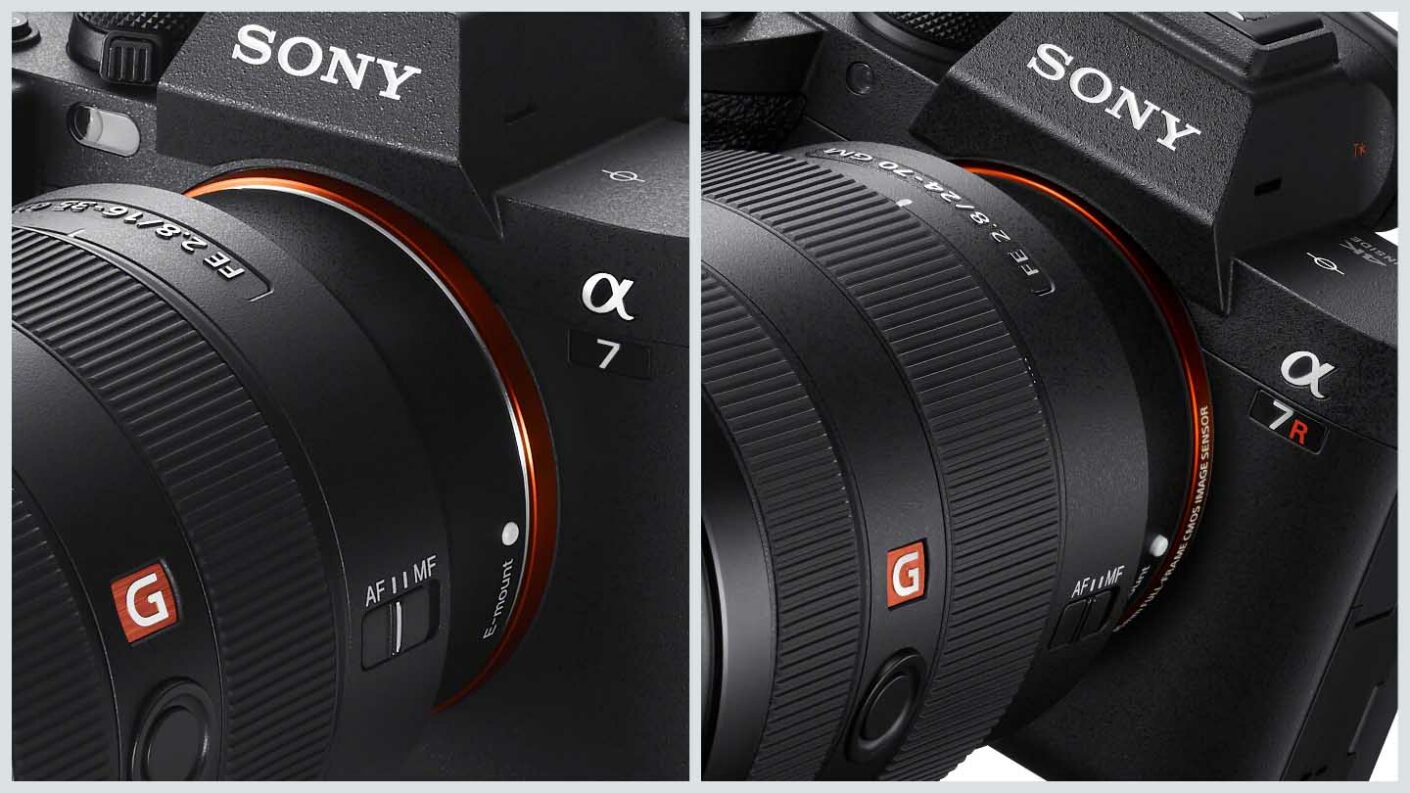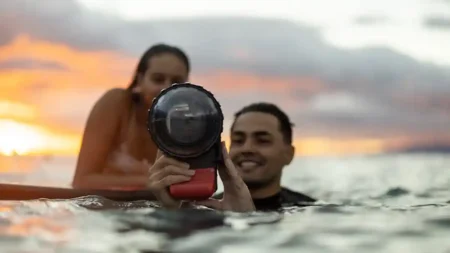Sony announced the A7R IV in July 2019 to replace the 42.4Mp Sony A7R III. With an effective pixel count of 61Mp, it is the highest resolution full-frame mirrorless camera currently available and it’s capable of capturing a fantastic level of detail.
However, in October 2021, Sony introduced the A7 IV, the replacement for the A7 III. With a pixels count of 33Mp, it doesn’t have as high a resolution as the A7R IV, but the A7 IV is a great all-rounder and it’s significantly more affordable. In this post, we’ll take a look at the key differences between the two cameras to help you decide which to buy, or if you should sell one to buy the other!
Sensor
- Sony A7 IV: 33Mp BSI full-frame (35.9 x 24.0mm) Exmor R CMOS sensor
- Sony A7R IV: 61MP BSI full-frame (35.9 x 24.0mm) Exmor R CMOS sensor
Both cameras have the same sensor design, which is backside-illuminated but not stacked like the Sony A1 sensor. However, the Sony A7R IV has a 28Mp higher resolution than the A7 IV, which is an increase of around 46% in pixel count. It means that you can make significantly larger prints or more dramatic crops if you can’t get close enough to your subject.
Being a more recent introduction, the A7 IV features the newer Bionz XR processor while the A7R IV has the older Bionz X processor.
Sensitivity (ISO) range
- Sony A7 IV: Stills: ISO 100-51,200 (expandable to ISO 50 to ISO 204,800), Video: ISO ISO 100-51,200 (expandable to ISO 100-102,400)
- Sony A7R IV: Stills: ISO 100-32000 (expandable to ISO 50 to ISO 102400) Movies: ISO 100-32000
Having a lower resolution than the A7R IV gives the Sony A7 IV an advantage in low light as its pixels are larger so they gather more light and generate a stronger image signal. Consequently, the A7 IV has a higher maximum ISO setting than the A7R IV and it produces cleaner images as the ISO value climbs. This makes the A7 IV a better choice for low-light photography.
Autofocus system
- Sony A7 IV: Hybrid AF with 759 phase detection points and 425 contrast detection points
- Sony A7R IV: Hybrid with 567 phase detection and 425 contrast detection AF points
Both cameras have Sony’s Hybrid AF system that uses phase and contrast detection, however, the A7 IV has 759 phase detection points, 192 more than the A7R IV. These points cover 94% of the A7 IV’s imaging area while the A7R IV’s cover 99% of the height and 74% of the horizontal area.
The two cameras also have sony’s Real-time Eye AF which in stills mode can be set to detect human or animal eyes on the A7R IV, and human, animal or bird eyes on the A7 IV. In video mode, the A7R IV can only detect human eyes but the A7 IV can locate and track human, animal or bird eyes.
In another plus for the A7 IV, its AF system is more sensitive, operating at down to -4EV rather than -3EV with the A7R IV.
Video capability
- Sony A7 IV: 4K (3840 x 2160), 60p, 600Mbps with Super 35 crop
- Sony A7R IV: 4K (3840 x 2160), 30p, 100Mbps with or without Super 35 crop
Both cameras are capable of producing great-quality 4K video, but the A7 IV has a bit more up its sleeve with 10-bit 4:2:2 video being recordable internally or externally via HDMI.
While you have to use the Super 35 crop to shoot 4K video at 60p with the A7 IV, you also get 600Mbps. And if you drop the frame rate to 30p, you can shoot 4K video using the full sensor with 7K oversampling.
Although the A7R IV can shoot 4K 30p video using the full sensor, it uses line skipping so the best results are captured when the Super 35 crop is applied.
While the A7R IV has Sony’s Creative Styles to give videos and still a certain look, the A7 IV has the newer Creative Looks profiles that were introduced with the A7S III. Both cameras feature S-Log recording.
Storage
- Sony A7 IV: Dual: Slot 1: SD/SDHC/SDXC UHS-II & CFexpress Type A, Slot, 2: SD/SDHC/SDXC UHS-II
- Sony A7R IV: Dual SD/SDHC/SDXC
The Sony A7R IV and A7 IV can both accept two SD type cards and all the slots are compatible with UHS-II or UHS-I media. However, Slot 1 in the A7 IV is also compatible with CFexpress Type A cards. These cards aren’t yet common and they’re more expensive than the same capacity SD cards, but they enable the fastest shooting speeds, burst depths and highest video frame rates.
Continuous shooting
- Sony A7 IV: 10fps 1,000+ Jpeg or lossy/lossless compressed raw files
- Sony A7R IV: 10fps for 68 Jpeg or compressed raw files
The ability to shoot at 10fps for 68 images with a 61Mp camera is pretty impressive, but it’s something you might want to do with caution as your memory card and computer storage are likely to fill up quickly.
33Mp images are more manageable, which makes the A7 IV a more natural choice for keen sport and action photographers. Also, if you want to shoot uncompressed raw and Jpegs simultaneously, provided a CFexpress Type A card is in use, you can get up to 828 images in one sequence.
When I tested the A7IV with a 300MB/s V90 SDXC card, I was able to shoot at 10fps for 197 Extra Fine Jpegs. Switching to Uncompressed raw files and Extra Fine Jpegs simultaneously, dropped the rate to around 6.5fps for 32 images while shooting Lossless compressed raw files enabled a rate of around 6.7fps for 54 images.
Viewfinder
- Sony A7 IV: 0.5-inch 3,686,400-dot OLED
- Sony A7R IV: 0.5-type 5,760,000-dot OLED
Thanks to its higher resolution, the A7R IV’s viewfinder wins this one. The A7 IV’s viewfinder is still good, but the A7R IV’s looks a little crisper and more natural to the eye.
Both give a good preview of the final image, accurately displaying the colour and exposure.
Screen
- Sony A7 IV: 3-inch 1,036,800-dot vari-angle touchscreen
- Sony A7R IV: 3-inch 1,440,000-dot tilting touchscreen
While the higher resolution of the A7R IV’s tilting screen might make it preferable to some, we prefer A7 IV’s screen because it’s mounted on a vari-angle hinge and there’s much more use made of the touch-control.
We like being able to twist the A7 IV’s screen into position to give a clear view whether we’re shooting in landscape or portrait orientation. It can also be flipped round so it’s visible from in front of the camera.
In addition, the A7 IV has the revised menu structure that Sony introduced with the A7S III, it makes finding the option you want easier. Plus, with the A7 IV, you can Mae menu setting selections with a tap on the screen.
Pixel Shift Multi Shooting
- Sony A7 IV: No
- Sony A7R IV: Yes, using 4 or 16 images
Just in case a 61Mp image doesn’t capture quite enough detail, the A7R IV features Sony’s Pixel Shift Multi Shooting technology that enables it to move the sensor by a tiny amount between 4 or 16 shots taken in sequence. These images can then be composited on a computer running Sony’s Imaging Edge software to create a 240.8Mp (19,008 x 12,672) image using data from the equivalent of approximately 963.2Mp.
Pixel Shift Multi Shooting mode requires a motionless subject and the camera to be tripod-mounted, so it’s of greater use for commercial photography than landscapes, but it’s a nice option to have on occasion.
Dimensions and design
- Sony A7 IV: 131.3 x 96.4 x 79.8mm, 658g with battery and memory card
- Sony A7R IV: 128.9 x 96.4 x 77.5mm, 665g with battery and memory card
Although they are very similar in size, weight and design, the Sony A7 IV is a little bigger than the A7R IV because of its heat-dissipating construction.
Their control arrangement is also very similar but there are a few differences such as the video record button is on the top of the A7 IV, near the shutter button, rather than on its back like on the A7R IV.
The A7 IV also has a switch under the mode dial that allows the shooting mode to be changed quickly from stills to video or S&Q mode. Also, the exposure compensation dial doesn’t have markings as it can be customised for another purpose.
In addition, the A7 IV has a full-size HDMI port while the A7R IV has a microHDMI Type D port.
Should I sell my Sony A7R IV?
While many photographers buy the Sony A7R IV specifically for its high resolution and large files, some photographers discover that this gives them storage and processing issues. Also, the A7R IV’s files aren’t as clean as the A7 IV’s at higher ISO settings.
Unless you need the larger images of the A7R IV, the A7 IV is a better camera in many ways, with the viewfinder being one of the few exceptions. The A7 IV’s 33Mp files capture more detail than the 24Mp full-frame competition, but it doesn’t choke your storage too quickly. It’s a very capable camera that can be used to capture a wide range of subjects including fast-moving sport, portraits and weddings.
Sponsored: Thinking of selling your Sony A7R IV or another camera to upgrade? Selling your gear to MPB is the most secure way to do it. With free doorstep pickup, super-fast payment plus over 300,00 customers and five stars on Trustpilot. Buy. Sell. Trade. Create.




Hi, Thanks for the helpful review. I’ll reopen this page in a browser without ad blocking, as per your kind request.
Thank you for your kind comment and for turning off the ad blocker!